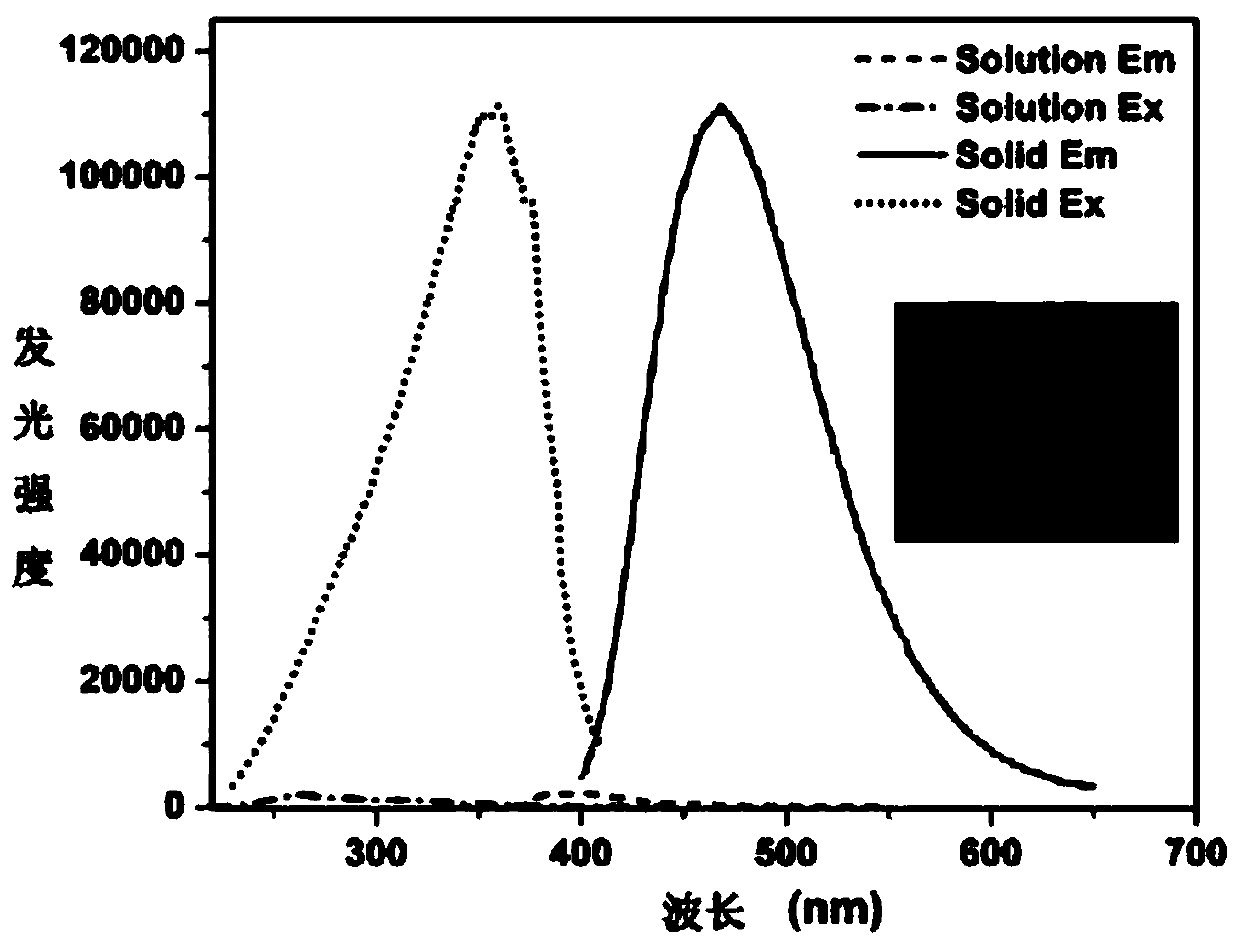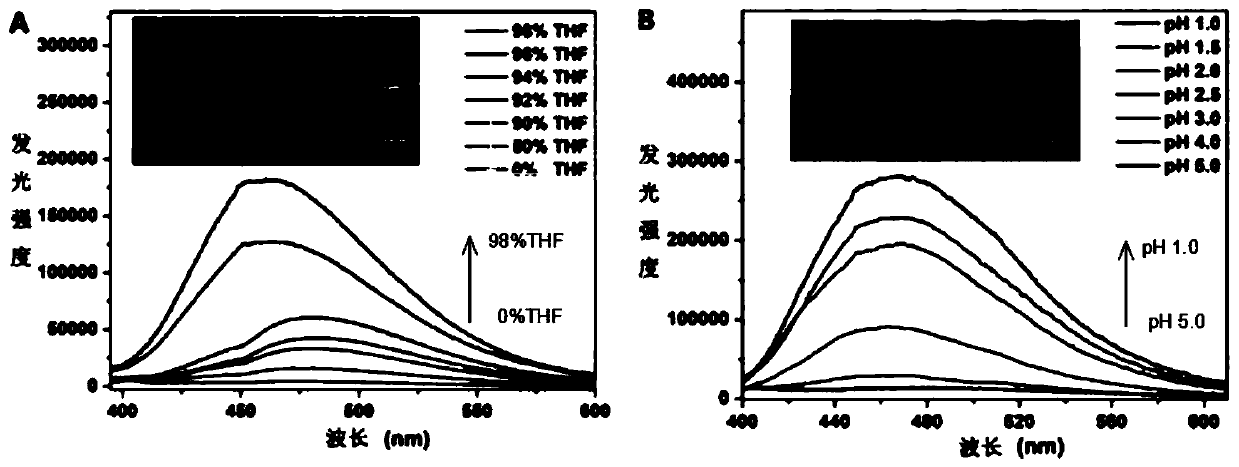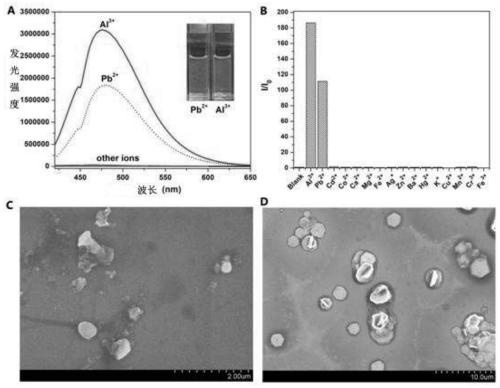Aggregation-induced luminescence molecular probe capable of realizing selective identification on lead ions and aluminium ions, and preparation method and applications thereof
A technology of aggregation-induced luminescence and molecular probes, applied in chemical instruments and methods, preparation of organic compounds, preparation of ethers, etc., can solve the problems affecting the sensitivity and accuracy of tracking Al3+, no molecular probes, poor probe solubility, etc. , to avoid self-precipitation, increase water solubility, and achieve the effect of good solubility
- Summary
- Abstract
- Description
- Claims
- Application Information
AI Technical Summary
Problems solved by technology
Method used
Image
Examples
preparation example Construction
[0049] This embodiment discloses the molecular probe TPE-4CO that first discloses 2 The preparation method of Na comprises the following steps:
[0050] Step 1, preparing 1,1,2,2-tetrakis(4-methoxyphenyl)ethylene;
[0051] The synthesis method is as follows:
[0052] Zinc powder (1.84g, 28mmol) and TiCl 4 (1.58ml, 14mmol) in 50ml dry THF, refluxed under nitrogen atmosphere for 2h. A solution of 4,4-dihydroxybenzophenone (1.50 g, 7.0 mmol) in dry THF (20 ml) was added to the above suspension, followed by reflux at 80° C. for 12 h. After cooling the reaction mixture to room temperature, add 10% K 2 CO 3 (50 mL) in water. The resulting product was extracted with ethyl acetate. The solvent was evaporated under vacuum and the crude product was purified on a silica gel column using ethyl n-hexane: ethyl acetate (1:1, V / V) as eluent. The yield of 1,1,2,2-tetrakis(4-methoxyphenyl)ethylene was 70% (1.01 g).
[0053] Step 2, synthesizing 1,1,2,2-tetrakis(4-hydroxyphenyl)ethylen...
Embodiment 2
[0068] This embodiment uses the probe TPE-4CO that embodiment 1 makes 2 Na for the identification and detection of aluminum ions and lead ions: for the quantitative detection of Al 3+ , first prepare a fixed concentration (20.0μM) of TPE-4CO in HEPES buffer (pH7.0) 2 Na solution, and then different amounts of Al in the range of 0.0–650.0 μM 3+ respectively added to the above TPE-4CO 2 in Na solution. The PL spectrum of the resulting mixture was recorded using a xenon arc lamp under excitation at 355 nm. will Pb 2+instead of Al 3+ , with the same method for Pb 2+ Quantitative detection of Pb 2+ The dosage is in the range of 0.0–500.0μM, such as Figure 4 (C) and (D) shown.
[0069] to Al 3+ and Pb 2+ The selectivity test is as follows;
[0070] TPE-4CO in HEPES buffer 2 Add quantitative amounts of different kinds of metal cations (100.0 μM) to Na solution (20.0 μM), including K + ,Mg 2+ , Ca 2+ , Ba 2+ ,Al 3+ ,Pb 2+ ,Cd 2+ ,Co 2+ , Fe 2+ , Ag + ,Zn 2+ ,H...
Embodiment 3
[0075] This embodiment uses the TPE-4CO that embodiment makes 2 Na in live cell imaging of aluminum ions in Arabidopsis root cells, the specific steps are as follows:
[0076] There is a large amount of glutathione in Arabidopsis root cells, and glutathione has a masking effect on lead ions, so based on TPE-4CO 2 Discriminative detection strategy for Al versus Pb ions of Na, enabling specific imaging of Al in living cells 3+ .
[0077] The specific operation steps are as follows:
[0078] Step 1. Disinfect the surface of Arabidopsis wild-type seeds, soak them in the dark at 4°C for 3 days, and then sow them on 0.5× medium 1.5% (w / v) plates;
[0079] Step 2, placing the flat plate sown with Arabidopsis wild-type seeds in a climate-controlled growth chamber to vertically grow the seedlings on the flat plate;
[0080] Cultivation conditions in a climate-controlled growth chamber were as follows:
[0081] Day / night temperature: 22 / 20°C;
[0082] Photoperiod: 16 / 8h;
[0083]...
PUM
 Login to View More
Login to View More Abstract
Description
Claims
Application Information
 Login to View More
Login to View More - R&D Engineer
- R&D Manager
- IP Professional
- Industry Leading Data Capabilities
- Powerful AI technology
- Patent DNA Extraction
Browse by: Latest US Patents, China's latest patents, Technical Efficacy Thesaurus, Application Domain, Technology Topic, Popular Technical Reports.
© 2024 PatSnap. All rights reserved.Legal|Privacy policy|Modern Slavery Act Transparency Statement|Sitemap|About US| Contact US: help@patsnap.com










